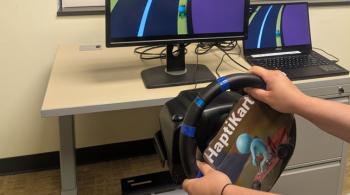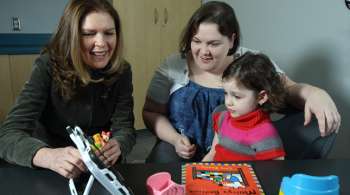by Mary Lashno, OTR
For many children with Down syndrome and autistic spectrum disorder (DS-ASD), sensory integration (SI) is one intervention to consider. Many times, the way a child with DS-ASD behaves or reacts is because he processes sensory information from the situation differently than other children. This article explains sensory integration, how it effects behavior in children with DS-ASD and offers some suggestions for common sensory-related behaviors for you can use while you set up an appropriate SI program with a trained therapist.
Sensory integration is the process of taking in information from the environment through various sensory systems (touch, smell, sight, movement, sound and the pull of gravity on the body). Information is processed through the brain. The brain then interprets, organizes and directs the body to respond appropriately to that sensory information. Sensory experiences happen continually and as they do, your child continues to learn and respond to his environment in more complex ways.
If you watch a small baby play, you may be able to get a better sense of what sensory integration is. A baby's primary learning senses include vision, skin (tactile), movement and gravity (vestibular), and muscles, joints and ligaments (proprioception). As a child lies on his belly, his mother may place a musical ball in front of him. Following initial movement and sound, the child may try to lift his head to view the object. Initially, this will be difficult due to the pull of gravity, pushing his head back to the floor. Normal curiosity and "inner drive" will engage the child to continue to work on raising his head (vestibular). His arms and legs will also move (proprioception) in an effort to help keep his head up in order to view the toy. His brain is organizing and sequencing all the sensory information received with each movement of arms, legs and head. His muscles are responding in a way to help him achieve his goal of looking up to see the toy. With each "adaptive response," he continues to refine his skills. As he achieves a certain level of success, he continues to "up the ante" and eventually he will be able to reach forward, touch the ball, make it move and pull it towards him to play. This child's sensory system is organizing information in order to allow him to learn and successfully master his environment. When basic senses are integrated, the child continues to learn and grow from sensory information. Through movement and experiences, he learns how to move against the pull of gravity and feel comfortable with his body awareness in space. He begins to develop a mental picture of where his body parts are and how they are related to him.
If you watch a small child learn a new task, initially a great deal of concentration and effort are noted. The task appears clumsy but as he continues to "practice," his skills become more proficient and not only has he mastered the task but will continue to make it more challenging. This is sensory integration.
Unfortunately, there are some children whose sensory systems do not develop efficiently. They may have a sensory processing disorder. A child with a sensory disorder gathers information from sight, sound, touch, movement and pull of gravity like any other child. However, when the data enters the brain, it is not organized or processed correctly. As a result, the brain sends out an inappropriate response. Learning is based on this information and abnormal response or behavior are usually noted. The brain can respond in two ways.
Hyporesponsive -- in spite of large amounts of sensory input, the brain fails to register and doesn't respond to input.
Hyperesponsive -- the brain "short-circuits" and registers sensations too intensely.
Let's break this down to get a better picture of these responses. Most children enjoy being touched by their parent. A light touch on the hand or head usually makes a child respond positively. However, there are some children who view this touch as a "fight or flight" response. That is a hyperesponsive response. The brain records this as danger and the child reacts by screaming, pulling away or avoiding this touch or sensory input. The response is comparable to walking down an unfamiliar dark alley at night. All of our senses are on "alert" in order for our body to respond to danger. Our eyes widen, our breathing is shallow, heart beats faster and we are preparing our body to respond by either running or fighting to avoid danger. Imagine if your system was always on alert and you felt that every touch or movement meant danger. It would be very difficult to explore your environment and learn from those experiences because your brain is constantly registering danger. As a result, many children who are hyperesponsive avoid any form of input through tactile (touch) vestibular (gravity), or proprioceptive (movement). Due to the brain's abnormal response to sensory input, this child usually avoids input and doesn't actively explore his environment, thereby missing out on valuable sensory learning experiences. This child may also prefer certain positions and scream with any type of transition or change in daily routine. He may avoid certain clothes, food textures, hate movement or sit in one position and perform a perseverative (same action repeated over and over) movement in an effort to "calm" down his system.
The hyposensative child may be viewed as someone who constantly bombards his sensory system in an effort to gain appropriate sensory information. This child may be constantly touching objects, mouthing everything in sight, bumping into walls or falling repeatedly. He may fall or hurt himself, but doesn't appear to respond to pain in a way you expect such as crying, rubbing his arm and so on. A hyposensitive child doesn't process information correctly: he may bang into the same object repeatedly. For example, a child with a normal sensory system may run into the room and not see a toy on the floor. He may fall, get up and continue to play. If he comes into the room again, he will not necessarily look at the toy on the floor but rather his body and postures will adjust to run around the object rather than falling into it again. Suppose you were in a darkened room, unable to see and you were told to find your way out. You would immediately try to "call in" all other senses available in order to gather as much information to find your way out of the room. You would touch the walls, feel the floor, and listen for clues to be successful. This works fine if your sensory system works well; however, someone who is hyposensitive will use their brain to constantly search for information in this intense way to "make sense" of the world.
Although it seems as though a child could fall into either category, the majority of children with a sensory processing disorder fall into both categories. This means they can be hyporesponsive to some input and hyperesponsive to other types of input. Also, even though their brains are not processing information in a "normal" format, they will exhibit behaviors that may appear "weird." In actuality, they are trying to make sense of input and will often seek out what they feel their brain is requesting. For example, if they feel they need proprioceptive input they might jump, push or pull; for vestibular input they might spin or rock; for tactile input they might seek deep pressure. They may also demonstrate odd behaviors, such as, playing only in a specific area, not explore a room, avoid certain toys, move or run around constantly, purposely run into walls or push people.
Children tend to know what sensory information they need and although these behaviors appear strange to us, it is the child's way of making sense of his environment and trying to adapt to daily life. It should be noted, that all of us will have quirks about certain types of input and we adapt to the conditions. However, as long as it does not impact our ability to learn and function within our environment, it is not considered an issue. Children with a sensory dysfunction are unable to learn and function within their daily routine and until they can "make sense" or modulate the input (turn up or down the sensory response for the brain to process and respond appropriately) they will continue to demonstrate a dysfunctional sensory system.
Through therapeutic intervention, an occupational therapist provides the appropriate sensory input in order to help the child modulate information correctly. The child will then begin to register, modulate and respond in a normal fashion which will increase exploration and allow learning to happen.
Some of the children I have seen through Down Syndrome Clinic who have DS-ASD demonstrate the areas of concern discussed above. Families will usually report that their child was developing within normal limits for a child with Down syndrome only up until they were around a year old. At that time, they began to demonstrate decreased skills in playing, social interaction and many abnormal behaviors. Some on these reported behaviors include shaking fingers, chains and similar objects in front of their face, food refusal, looking directly into a light source and preservative type motions rather than purposeful play. Some of the other behaviors that have been reported or observed by families of children with DS-ASD include:
- Decreased or no eye contact,
- Excessive mouthing of objects,
- Decreased or no purposeful play with toys,
- Staring directly into lights,
- Abnormal hand movement (such as flicking fingers in front of eyes or waving hands away from body),
- Refusal to hold objects (such as clothing or a spoon to self-feed),
- Picky eater (especially for specific textures),
- Flat affect,
- Self stimulatory behaviors (such as rocking, banging head, humming or screaming), and
- Decreased interaction with people.
If your child sounds like the one listed above, he may be diagnosed with DS-ASD. Many of the behaviors listed are also noted in the children with autistic spectrum disorder. Additionally, it is well documented that many children with autistic spectrum have significant difficulty with sensory processing. It is easy to see that many of these "odd" behaviors could possibly be related to your child's attempts to calm down or make sense of the world through the sensory input they are receiving.
If your child has behaviors like the ones listed above and the behaviors are impacting developmental growth, therapeutic intervention is essential. The goal of a therapeutic sensory integration program for your child with DS-ASD is to normalize and help the child "make sense" of sensory input so he can explore and learn from his environment. Below is a list of goals and types of therapeutic intervention that may be helpful.
The first step of sensory integration therapy is to combine an informal observation with information you share about your child that is specific to sensory processing. You may be asked to fill out a questionnaire regarding your child's responses to various types of sensory input. This information determines your child's sensory processing function: what areas are hyper- or hypo-responsive to sensory input. The observations, evaluations and intervention for sensory dysfunction should be done by a therapist who is trained in and has experience with sensory integration. Through therapeutic intervention, the therapist will be able to provide the input needed, which allows your child to begin to "register" and respond more appropriately. Recommendations can then be made suggesting ways to provide specific sensory activities throughout your child's daily routine. The focus of treatment is to regulate your child's ability to register and modulate sensory input in order to allow the normal process of exploration and learning to develop.
Children with DS-ASD usually do not need to participate in a true sensory integration type of therapy. This is usually a very intensive therapy performed on a weekly basis for at least a year. SI Therapy for a child with DS-ASD most likely involves intervention once or twice a month. The goal is to determining sensory issues and provide treatment and to train you to carry-over activities at home and encourage them at school. As your child's sensory processing improves, therapy is reduced and focuses on providing activities for you to use with your child that increase his tolerance of sensory input.
Although therapy is highly recommended, it may not always be practical. It is not always covered by medical insurance, so the cost may be a problem as well as the availability of a trained occupational therapist. With that in mind, here is a list of some common behaviors seen in children with sensory processing concerns, possible reasons for the behavior, and suggestions that may be helpful. The bottom line is that as parents you spend the most time observing your child and, most likely, you have already begun to provide the child with the types of input that they are seeking.
Constant mouthing of objects, chewing on clothes and other objects
If your child is constantly mouthing or chewing, it may be one method he uses to calm himself. Here are some suggestions:
- Give your child various types of textures or stimuli to mouth such as, the Discovery Toy that is rubber and has 4 different types of tips or nubs. Each provides a different type of sensory input.
- Give some deep pressure to the face with your hands, his hands or a terry cloth towel going in a slow, downward direction.
- Vibration is often enjoyable if it is introduced slowly. Be cautious with this type of sensory input and use it sparingly. Try to let your child dictate how much or little vibration massage he receives.
- Chewing on therapy tubing or drinking milkshakes or Slurpees through a straw are often helpful.
- Chewy or crunchy foods such as pretzels, trail mix, Starburst may also be a preferred activity for your child.
Refusal to hold items in hands
If your child is hypersensitive in the hands, he will resist holding objects in his hands. He may become very upset if his hands are dirty or need to be cleaned. When he holds an object, it is with a very weak grasp that is more at the fingertips than the palm. Yet he may hold onto certain, preferred objects. Instead of purposeful play, however, he will use a preservative type motion, such as banging two blocks together or throwing off a tray, shaking and so on. He is only able to process limited amounts of information from the object, which is seen more in loud, banging activities rather than purposeful play. If this sounds like your child, he may benefit from the following activities:
- Provide deep pressure to the hands, such as placing your hand firmly on top of his and guiding him through an activity.
- Offer vibration on his hands from toys such as a Bumble ball™.
- Provide various types of textures, such as soft, hard, scratchy. Be sure to consistently monitor your child's response to the input.
- Provide various types of textures within a child's reach (such as a basket or box), which will allows your child access to explore these items on his own.
Purposely banging into walls, furniture, pushing or knocking over objects.
If your child seems to purposefully bang into walls, furniture or knock over objects, he probably is not processing movement. Through these activities he is seeking the sensation of movement either through rocking, spinning, banging into objects or walls. He may also be trying to provide his body with deep pressure in an effort to calm his system. Some suggested activities include:
- Fill a wagon or box with heavier objects that child could push or pull around the room.
- Fill a backpack with heavier books (within reason) and putting the backpack on your child's back. This may provide the feedback the child needs to understand where his body is in space.
- Other activities that provide proprioceptive input, such as deep pressure, roughhousing, jumping on a small trampoline (with supervision), tug of war or wrapping up in a blanket may help him calm and process information more appropriately.
Excessive spinning or rocking:
If your child spends too much time rocking or spinning, he may be trying to calm his system down. He may also be seeking movement input. Activities that may be helpful include:
- Using of a child size rocker, rocking horse, or you slowly rocking him in your lap with deep pressure provided (holding him snugly).
- Watch your child during these activities. If your child calms with the rocking, he may also benefit from your singing rhythmic songs or playing calm music while he rocks.
Looking into bright lights, flicking fingers and dangling objects in front of the face:
If your child likes to look into lights, flicks his fingers or dangles things in front of his face, he is probably looking for ways to increase visual input. To do this he is exhibiting a self-stimulatory type of behavior, such as light flashing on a shiny object being moved in front of the eyes, staring at a bright light and so on. Although he will want to continue these behaviors, you may want to try to put a purpose to the activity. Some ways to do this include:
- Providing toys that provide bright lights that turn on and off with a switch. Provide hand-over-hand assistance with the switch as needed to encourage your child to activate the toy independently.
- Provide deep pressure over his hands when he dangles objects in front of his face. When you do, help "walk " him through placing objects in various type containers, shaking, opening, closing and hiding objects.
Learning to add purpose to these self-stimulatory behaviors is a slow, process and may take some time to transition your child into use of the object in a more purposeful task.
In addition to these suggestions, I highly recommend sensory integration treatment be performed and guided by an occupational therapist trained in sensory integration. Although the suggestions listed above may prove helpful, they are only general suggestions and may not work for your child. Continue to observe, be patient and use creativity as you work with your child. As he begins to accept sensory input that he is able to process and "make sense" of, his ability to use hands and body will increase along with his ability to play and interact within his environment.
Mary Lashno, OTR, is a registered occupational therapist trained in sensory integration therapy. She currently practices at Kennedy Krieger Institute in Baltimore, Maryland.
The article above is reproduced from the September/October 1999 issue of Disability Solutions, Volume 3, Issues 5-6. Permission was granted for its use on this web site. In accordance with federal copyright restrictions, the contents of this article may not be reproduced by photocopying or any other means without written permission from the copyright holder. © 1999 Disability Solutions















